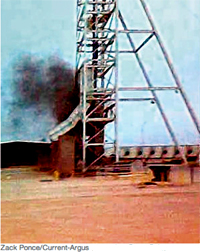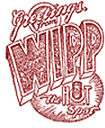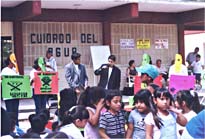 On February 14, 2014, The Waste Isolation Pilot Plant (WIPP) experienced the first accidental release that we know of. In fact, despite assurances to the contrary, as of this posting (April 13, 2014) the leak is still going on. Though it is leaking at a much lower rate, that rate is not zero. At least 21 workers who were on the surface at the site inhaled plutonium and americium—a very serious situation since there is no threshold of exposure to these materials below which you are "safe." Even very low levels of exposure can cause cancer.
On February 14, 2014, The Waste Isolation Pilot Plant (WIPP) experienced the first accidental release that we know of. In fact, despite assurances to the contrary, as of this posting (April 13, 2014) the leak is still going on. Though it is leaking at a much lower rate, that rate is not zero. At least 21 workers who were on the surface at the site inhaled plutonium and americium—a very serious situation since there is no threshold of exposure to these materials below which you are "safe." Even very low levels of exposure can cause cancer.
There were no workers underground because a mining truck had caught fire in the underground five days previously. Except for a small crew that checked on the burned truck, the underground had remained empty since the fire evacuation. At this time the cause of the release is unknown and it is also unknown whether or not the truck fire and the release are connected. For more detailed updates, go to the WIPP Radiation Leak page at the Southwest Research and Information Center's website.
WIPP management was blasted by the fire investigators for numerous safety and preparedness deficiencies that led to the truck fire and an almost botched evacuation. Over the last years, there has been a culture of reduced safety at the WIPP site and throughout the complex sending waste to the repository. In fact, when the leak occurred, the Department of Energy (DOE) was applying for modifications to their permit to further reduce the robustness of WIPP protections.
 -five years. In 2014, we are 15 years into the project.
-five years. In 2014, we are 15 years into the project.
Much of this waste is plutonium-laden. Plutonium is often termed the most dangerous substance known to man. Inhaling a miniscule amount of plutonium is likely to lead to lung cancer. Ingesting plutonium can lead to leukemia and other cancers of the bone and bone marrow. This plutonium-laden waste travels from numerous sites through 23 states to reach its destination in SE New Mexico near Carlsbad—not far from Carlsbad Caverns, the region's most famous geological feature.
After eleven other states rejected the WIPP project, in 1978 the old Atomic Energy Commission (precursor to the Department of Energy) made a deal with a failing potash company to buy land and locate WIPP in New Mexico. No geological investigation was held before WIPP was sited.
Unfortunately, WIPP is located in one of the world's largest karstlands as evinced by Carlsbad Caverns, 'bottomless lakes', appearing and disappearing rivers such as the Rio Negro near Loving, sinkholes, and many other regional geologic features. Here, streams of water run underground dissolving the soft rock and old salt deposits as they flow, making the WIPP site an unsuitable location for permanent disposal of radioactive wastes. This siting disaster is made even worse by the numerous resources that exist above and below the site. Literally hundreds of oil and gas wells surround the repository.
Independent earth scientists believe that WIPP will contaminate the nearby Pecos River, used for irrigation and drinking water in the arid lands of west Texas and Mexico, down gradient from the repository.
 people and land of New Mexico from radioactive contamination. In the 1990's CARD became involved with Coalición Binacional contra Tiraderos Tóxicos y Radioactivos, a coalition whose mission encompasses halting the widespread practice of dumping toxic and radioactive waste along the US/Mexico border.
people and land of New Mexico from radioactive contamination. In the 1990's CARD became involved with Coalición Binacional contra Tiraderos Tóxicos y Radioactivos, a coalition whose mission encompasses halting the widespread practice of dumping toxic and radioactive waste along the US/Mexico border.
CARD is a mostly volunteer organization that works through committees to accomplish goals agreed upon during its annual retreat. CARD's current projects include research into WIPP's geological instability; a legal suit against the Department of Energy emphasizing its use of false science and concealed science while composing its environmental impact statements concerning WIPP; an education program for fourth through twelfth graders, including a presentation on "The Nuclear Industry in Our World" focusing on New Mexico, and the development of curriculum on radiation and health; an outreach project to share resources with communities in our region dealing with nuclear threats; support of the on-going work of Coalición Binacional; coordination of research and dissemination of information on radioactive contamination at Sandia National Laboratories; and direct action, which is currently focused on human rights and environmental abuses along the US/Mexico border.
Dr. Snow's research was supported by a grant from the Citizens' Monitoring and Technical Assessment Fund.